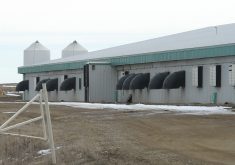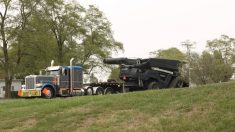FARGO, N.D. – Mike Gasper installed a TireBoss on one of his sugar beet semis last fall as an experiment.
He has since outfitted four more, plus four straight trucks.
“The inflation system makes a huge difference,” said the sugar beet grower from Crookston, Minnesota.
“That first semi last fall was going in anywhere our straight trucks could go, and it was sometimes better than the straight trucks.
“Opening fields last year, we noticed the straight trucks without the inflation system were making deep ruts. The semi with inflation wasn’t leaving ruts. It’s not the trailer making ruts. It’s the driving axle spinning down.”
Read Also

Phosphate prices to remain high
Phosphate prices are expected to remain elevated, according to Mosaic’s president.
Mud is no stranger to beet farmers. In a wet year, they count on just about every truck needing a pull every time it enters the field.
Before he installed the air systems, Gasper had two full-time pull tractors to keep his 10 truck fleet moving.
Now that nine of the trucks are equipped, he has only one pull tractor and it is idle much of the time.
Gasper’s drivers run the system at 70 pounds per square inch when they’re running empty on the highway, which he said eliminates much of the bounce.
The driver dials in 15 to 18 psi when the truck hits the field and tire pressure increases as the truck gradually loads. Pressure goes up to the normal 100 p.s.i. once it’s out of the field and on a hard surface.
Gasper said he was skeptical when he first saw all the hoses and hardware hanging out in the open, which is why he only bought one system.
“We installed it and then I watched that big mud buildup you get on the drive wheels. There’s wads of beet tops and heavy gumbo clay and it’s a mess to deal with.
“The hoses were acting like mud scrapers, cleaning off the tires. My first thought was to clean off the wheels before something got broken, but there’s no point in doing that because it builds up again in two minutes.
“So I let it go just to see how tough this stuff really is. And it never failed.”
Gasper said he also worried about the beet piler catching a hose and ripping it off, but so far that hasn’t happened.
He thinks there may be advantages to also putting the inflation on front tires, but he’s reluctant to try it because of safety concerns.
“It scares the hell out me to do any experimenting on the steer axle. The inflation system would probably help in the field, but the consequences are just too scary.”
He said payback on the system has come quickly.
“I wouldn’t have invested $60,000 or $70,000 in the systems if I hadn’t seen it work with my own two eyes on that first semi last year.
“We used to have a tremendous cost in drive train repairs, downtime and keeping two pull tractors running. I think that’s all behind us now.”















